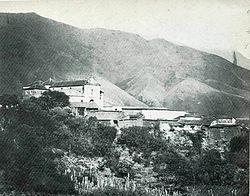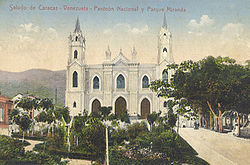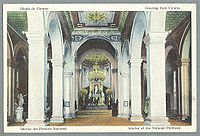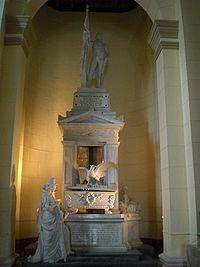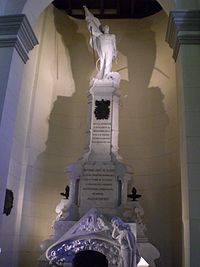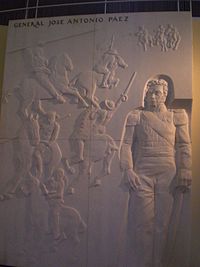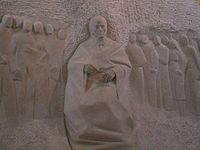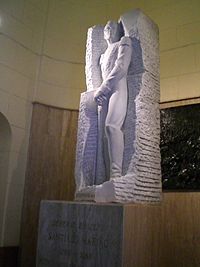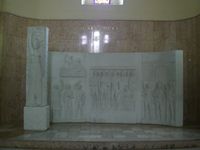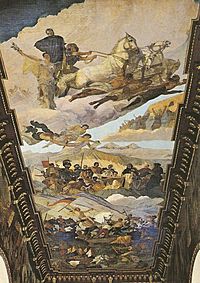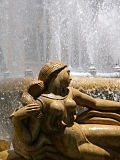- National Pantheon of Venezuela
-
National Pantheon of Venezuela 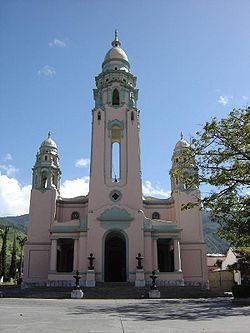
Details Year established 27 March 1874 Country Venezuela Location Caracas Coordinates 10°30′46″N 66°54′45″W / 10.5129°N 66.9126°WCoordinates: 10°30′46″N 66°54′45″W / 10.5129°N 66.9126°W Type Public Owned by Venezuelan government The Panthéon (Latin Pantheon,[1] from Greek Pantheon, meaning "Temple of all the Gods") is a building in the northern edge of the old town of Caracas, Venezuela. It was originally built as a church, but is now used as a famous burial place. The entire central nave is dedicated to Simón Bolívar, with the altar's place taken by the hero's bronze sarcophagus, while lesser luminaries are relegated to the aisles. The national pantheon's vault is covered with 1930s paintings depicting scenes from Bolívar's life, and the huge crystal chandelier glittering overhead was installed in 1883 on the centennial of his birth.
Contents
History
On 27 March 1874, president Antonio Guzmán Blanco decreed the transformation of the Santísima Trinidad church of Caracas into a National Pantheon, to conserve the remains of the heroes of Independence and those of eminent people. This church was constructed by Juan Domingo del Sacramento Infante in the middle of the 17'th century, the 1812 earthquake destroyed it almost totally, its slow reconstruction continued under the direction of several engineers and when was decree as Pantheon, it was still not finished.
The choice of this temple for so lofty a destiny was motivated as much by its then-panoramic and distant position from the urban nucleus of Caracas, as by its historical antecedents, during the return of Simón Bolívar's remains from Santa Marta in 1842, they were deposited temporarily at this church. In the church were also buried, in 1851, the remains of Francisco Rodríguez del Toro (Marqués del Toro), those of José Gregorio Monagas, Andrés Ibarra and Ezequiel Zamora. The decree of Guzmán Blanco was accompanied with the order of the completion of its facades, being finished the project made by engineer José Gregorio Solano during 1853-1858. It was the first design of neogothic architecture in Venezuela, consisted of a symmetrical facade of three doors and two angular towers. The works were led, successively, by the engineers Julian Churión, Juan Hurtado Manrique, Tomás Soriano and Roberto García, finishing on 28 October 1875. Nevertheless, the inauguration of the building occurred during St. Simon's day, when the remains of the Liberator were transferred from the cathedral. These were placed in a wooden sarcophagus with silver and gold coating, made in a neogothic style by the French engraver Emile Jacquin. The statue of the Liberator executed in 1842 by the Italian sculptor Pietro Tenerani was also transferred from the cathedral. The sarcophagus and the statue were placed in the space that was used by the priest of the church. From the ceiling, a crystal chandelier from Bacarat with 230 lights was hung. In 1910, the government of Juan Vicente Gómez undertook a general renovation of the building, following the plans of architect Alejandro Chataing. Some changes to the facade were introduced, and the inner decoration was modified, placing a sky-light in the ceiling of the nave.
The floor was paved with white, gray and black marble slabs. These works were finished in 1911, on the occasion of the centenary of Independence.
Another redesign of the Pantheon was ordered during Gómez government in 1929, according to the plans of architect Manuel Mujica Millán. This consisted of a radical change in the facades to a neocolonial and neobaroque design, adding in the front a third central tower 48 m high and replacing the lateral ones by others, all constructed of reinforced concrete. Also a new porch with a single entrance was added. The height of the lateral facades was increased, opening the windows in harmony with the internal chapels. Also, the entrance stairs were extended and made the more monumental. These works, which gave the building its present aspect, were undertaken during the year 1930 under the direction of Mujica and the engineers Edgar Pardo, Hernán Ayala and Guillermo Salas. Internally, corrections were made in the arches and the columns. The old wooden sarcophagus that contained the remains of El Libertador was replaced by one of bronze, designed by Spanish sculptor Chicharro Gamo and placed on a marble plinth. The previous marble pavement was replaced, the wooden ceilings were also replaced. The upper part of the nave and of the arches were covered by paintings with allegorical and historical subjects by painter Tito Salas.
National Pantheon
Inside the Pantheon, on both sides of the main recess that contains the tomb and monument to the Liberator, there are the statues of Francisco de Miranda and Antonio José de Sucre, respectively. Along the whole of the side walls, there are monuments dedicated to the First Republic, José Gregorio Monagas, Andrés Bello, José Antonio Páez, Rafael Urdaneta and José María Vargas and other important Venezuelan people. Under the pavement, in the two side caissons the remains of famous and illustrious Venezuelans are placed, labelled by tablets.
In 1963 the government decreed a regulation, establishing that the building must be opened to the public every day of the year. At the same time, the administration of the graves and other procedures are responsibility of the Ministry of Interior. In 1980, city-planning works to remodel the surroundings of the Pantheon were initiated in accordance with the study of architect Tomás Sanabria.
List of personalities who are buried at the Pantheon
- Cecilio Acosta. Writer, journalist and humanist. (5 July 1937).
- José Ángel de Álamo. Doctor, leader of the Independence movement. (9 May 1876).
- Francisco de Paula Alcántara. General in the War of Independence. (6 June 1876).
- Demetrio Alfaro. Officer in the War of Independence. (28 May 1876).
- Lisandro Alvarado. Doctor. (14 May 1980).
- Raimundo Andueza. Lawyer, soldier and politician, father of President Raimundo Andueza Palacio. (2 September 1881).
- Francisco Aranda. Politician. (18 May 1898).
- Juan Bautista Arismendi. Officer in the War of Independence. (29 January 1877).
- Jesús María Aristiguieta. Military and politician in the War of Independence. (18 March 1890).
- Carlos Arvelo. Doctor and politician. (16 December 1942).
- Rafael Arvelo. Journalist. (12 July 1877).
- Francisco de Paula Avendaño. Officer in the War of Independence. (16 March 1966).
- Rafael María Baralt. Writer and historian; ambassador to Spain. (23 November 1982).
- José Miguel Barceló. Military of the Federal War. (14 May 1878).
- Pedro Bárcenas. Doctor and officer in the War of Independence. (5 November 1877).
- Víctor Barret de Nazarís. Military and politician of the Federal War. (25 August 1896).
- Renato Beluche. Sailor in the Venezuelan Navy during the War of Independence. (22 July 1963).
- José Francisco Bermúdez. Officer in the War of Independence. (24 October 1877).
- Pedro Bermúdez Cousín. Lawyer, soldier and politician. (30 December 1875).
- Andrés Eloy Blanco. Poet and politician. (2 July 1981).
- José Félix Blanco. Priest. (3 July 1896).
- Manuel Blanco. Sailor who fought with San Martín and Simón Bolívar. (15 April 1876).
- Rufino Blanco Fombona. Writer and politician. (23 June 1975).
- Simón Bolívar. Liberator of Bolivia, Colombia, Ecuador, Peru, Panama and Venezuela. (28 October 1876).
- Justo Bricéño. Officer in the War of Independence. (21 May 1876).
- Mario Briceño Iragorry. Historian, writer and diplomat. (6 March 1991).
- Domingo Briceño y Briceño. Lawyer, journalist and writer. (6 May 1876).
- Luis Brión. Official of the Venezuelan Navy. (10 April 1882).
- Blas Bruzual. Military, politician and journalist. (16 August 1889).
- Manuel Ezequiel Bruzual. Military and politician. (13 November 1872).
- Lorenzo Bustillos. Officer in the War of Independence. (17 February 1877).
- Luisa Cáceres de Arismendi. Patriot and Heroine of the Venezuelan War of Independence. (14 August 1876).
- Josefa Venancio de la Encarnación Camejo. Heroine in the War of Independence.
- Francisco Carabaño Aponte. Officer in the War of Independence. (18 May 1876).
- Teresa Carreño. Pianist and composer. (9 December 1977).
- José de la Cruz Carrillo. Officer in the War of Independence. (15 December 1971).
- Carlos Luis Castelli. Officer in the War of Independence. (11 May 1876).
- Juan Francisco del Castillo. Lawyer, military and politician. (2 July 1893).
- Cipriano Castro. Military and President of Venezuela. (6 December 2002).
- Manuel Cedeño. Officer in the War of Independence. (16 December 1942).
- Lino de Clemente. Official of the Venezuelan navy. (21 July 1961).
- Agostino Codazzi. Military, scientist, geographer and cartographer.(16 December 1942).
- Juan Fermín Colmenares. Military and politician at the Federal War. (20 August 1881).
- Juan José Conde. Officer in the War of Independence. (19 May 1876).
- José María Delgado Correa. (20 May 1876).
- Manuel María Echeandía. (18 April 1876).
- Juan Crisóstomo Falcón. Soldier, politician, and President of Venezuela. (1 May 1874).
- León de Febres Cordero. Officer in the War of Independence. (16 December 1942).
- Carmelo Fernández. Officer in the War of Independence. (18 August 1983).
- Fernando Figueredo. Officer in the War of Independence. (29 June 1937).
- Alejo Fortique. Politician and diplomat. (30 April 1876).
- Rómulo Gallegos. Writer and politician, President of Venezuela. (3 May 1994).
- Juan Garcés. Soldier in the war of Independence. (26 November 1934).
- José María García. Navy officer in the War of Independence. (15 August 1896).
- Valentín García. Officer in the War of Independence. (27 April 1961).
- Miguel Gil. Soldier in the War of Independence. (5 August 1876).
- Francisco Esteban Gómez. Officer in the War of Independence. (20 August 1881).
- José de Jesús González. Military leader of the Federal War. (22 April 1897).
- Tomás Green. (24 August 1876).
- Guaicaipuro. Indigenous chief. (9 December 2001).
- Juan Bautista Guerra Carrillo.
- Manuel María Guevara. (10 August 1877).
- Antonio Leocadio Guzmán. Politician and journalist. (18 November 1884).
- Antonio Guzmán Blanco. Military, lawyer and President of Venezuela. (1999).
- Tomás de Heres. Officer in the War of Independence. (16 December 1942).
- Francisco Hurtado. (26 May 1876).
- Andrés Ibarra. Officer in the War of Independence. (24 August 1875).
- Diego Ibarra. Officer in the War of Independence. (20 October 1876).
- Francisco de Ibarra. Priest. (9 November 1880).
- Juan Domingo del Sacramento Infante. Bricklayer, constructor of the Santísima Trinidad Church (Current National Pantheon). (13 December 1780).
- Tomás Lander. Journalist, farmer, politician, and propagator of Venezuelan liberal thought. (5 April 1884).
- José Prudencio Lanz. (21 April 1876).
- Jacinto Lara. Officer in the War of Independence. (24 July 1911).
- Francisco Lazo Martí. Doctor and poet. (27 October 1983).
- Andrés Olimpo Level. Magistrate, lawyer, politician and journalist. Active in the War of Independence. (28 November 1876).
- Francisco Linares Alcántara. Soldier and politician, President of Venezuela. (4 December 1878).
- Enrique Luzón. German-born and originally named Heinrich von Lützow Officer in the War of Independence. (12 December 1877).
- José Tomás Machado. Official of the Venezuelan Navy. (16 December 1942).
- Vicente Marcano. Engineer, chemist and geologist. (10 July 1991).
- Santiago Mariño. Officer in the War of Independence. (1 January 1877).
- Zoilo Medrano. Farmer leader of the Federal War. (22 April 1897).
- Ramón Ignacio Méndez de la Barta. Priest, lawyer and politician during the Independence War.(16 December 1942).
- Arturo Michelena. Painter. (29 July 1948).
- Guillermo Michelena Salías. Doctor, university professor, and science writer. (10 November 1891).
- Carlos Minchin. Officer in the War of Independence. (4 June 1879).
- José Gregorio Monagas. General in the War of Independence, President of Venezuela, Liberator of the slaves. (13 November 1872).
- José Tadeo Monagas. Military leader, President of Venezuela. (17 May 1877).
- Mariano Montilla. Officer in the War of Independence. (3 July 1896).
- Juan de Dios Monzón. Doctor, soldier and politician. (20 April 1876).
- José Trinidad Morán. Writer and officer in the War of Independence. (3 December 1954).
- Tomás Muñoz y Ayala. (14 June 1892).
- Pedro Navarro Bolet. (29 January 1878).
- Carlos Núñez. Member of the Patriotic Society during the Independence. (17 February 1877).
- Daniel Florencio O'Leary. Irish officer serving in the Venezuelan and Colombian army during the War of Independence. (10 April 1882).
- Manuel Germán Ojeda Muñiz. (20 December 1875).
- José Manuel Olivares. Officer in the War of Independence. (14 May 1876).
- José Antonio Páez. General-in-Chief of Venezuelan Independence. (19 April 1888).
- Miguel Palacio Fajardo. Doctor and lawyer. Officer in the War of Independence. (1876).
- Juan Antonio Paredes Angulo. Officer in the War of Independence. (16 September 1960).
- Francisco Vicente Parejo. Officer in the War of Independence. (18 May 1876).
- Ana Teresa Parra Sanojo. Writer. (7 November 1989).
- Jesús María Paúl. (11 February 1877).
- Miguel Peña. Lawyer and politician. (24 July 1911).
- Fernando Peñalver. Signer of the Act of Independence. (3 July 1896).
- Juan Antonio Pérez Bonalde. Poet. (14 February 1946).
- Gabriel Picón González. Officer in the War of Independence. (23 June 1975).
- Judas Tadeo Piñango. Officer in the War of Independence. (16 December 1942).
- Simón Planas. Politician. (26 August 1877).
- José Ignacio Pulido del Pumar. Officer in the War of Independence. (15 January 1881).
- José Luis Ramos. Humanist, founder of the Literary journalism. (16 August 1889).
- Rafael Rangel. Scientist who studied tropical diseases. (20 August 1977).
- Luis Razetti. Doctor and surgeon. (23 June 1982).
- José Rafael Revenga. Lawyer. (22 December 1969).
- Pedro Rodríguez. (12 December 1879).
- Simón Rodríguez. Bolívar's teacher. (28 February 1954).
- Francisco Rodríguez del Toro. Officer in the War of Independence. (9 May 1851)
- Donato Rodríguez Silva. Military and politician of the Federal War. (22 April 1897).
- Arístides Rojas. Naturalist. (22 September 1983).
- Cristóbal Rojas. Painter. (27 December 1958).
- Pedro Manuel Rojas Mercado. Military leader of the Federal War. (10 August 1876).
- Juan José Rondón. Officer in the War of Independence. (25 August 1896).
- Bartolomé Salom. Officer in the War of Independence. (5 July 1909).
- Tomás José Sanabria y Meleán. Lawyer and politician. (1 January 1896).
- Luis Sanojo. Lawyer and politician. (22 June 1978).
- José Laurencio Silva. Officer in the War of Independence. (16 December 1942).
- Juan Antonio Sotillo. Officer in the War of Independence. (9 January 1878).
- Carlos Soublette. Officer in the War of Independence, President of Venezuela. (7 February 1970).
- Fermín Toro. Politician and diplomatic. (23 April 1876).
- Pedro León Torres. Officer in the War of Independence. (16 August 1889).
- Martín Tovar y Tovar. Painter. (22 September 1983).
- José Vicente de Unda. Priest. (16 December 1942).
- Diego Bautista Urbaneja Sturdy. Lawyer and colonel. (22 October 1876).
- Adolfo Urdaneta. Son of Rafael Urdaneta. (24 November 1876)
- Rafael Urdaneta. Officer in the War of Independence. (16 May 1876).
- Wenceslao Urrutia. Lawyer and politician. (20 April 1876).
- Juan Uslar. German-born and originally named Johan Von Usler, in 1819 he brought more than 300 soldiers to aid the Venezuelans in their fight for independence. (16 December 1942).
- José María Vargas. Doctor and surgeon, President of Venezuela. (27 April 1877).
- Miguel Antonio Vásquez. Officer in the War of Independence. (c. 1920).
- José Joaquín Veroes. Colonel in the War of Independence. (16 December 1942).
- Francisco Javier Yánez. (1876).
- José Ramón Yépez. Official of the Venezuelan Navy. (22 August 1949).
- Ezequiel Zamora. Military leader of the Federal War. (13 November 1872)
- Miguel Zárraga. Officer in the War of Independence. (10 May 1876).
The following personalities in the preceding list are not buried in the Pantheon because their remains have not been found, but it has been decreed by the Venezuelan authorities they should be[2]:
- Francisco de Miranda. First leader of the Venezuelan Independence, participant at the American Revolutionary War and the French Revolution.
- Josefa Camejo. Heroine of the Independence War.
- Guaicaipuro. Indigenous chief that fought against the Spaniards.
- Manuel Piar. General in chief of the army during the Independence War.
The following person is not buried in the Pantheon but an empty tomb is kept there, next to Simon Bolivar's in the hopes that his remains will return to his homeland:
- Antonio José de Sucre. Hero of the Independence War, founder and first President of Bolivia
Monuments
Central Nave
- Monument to Simón Bolívar by Pietro Tenerani.
Right Nave
- Monument to the First Republic by Hugo Daini.
- Monument to José Gregorio Monagas by Julio Roversi.
- Monumento to the Federation by Juan Bautista Sales Ferré.
Left Nave
- Monument to José Antonio Páez by José Pizzo.
- Monument to Rafael Urdaneta by Pietro Ceccarelli.
- Monument to José María Vargas by Franco Bianchinni.
- Monument to Santiago Mariño by Manuel de la Fuente.
Cenotaphs
- Cenotaph in honor of Francisco de Miranda by Julio Roversi.
- Cenotaph in honor to Antonio José de Sucre by Juan Bautista Sales Ferré.
- Cenotaph in honor to Andrés Bello by Manuel de la Fuente.
Works of Tito Salas
- Alegoría de la libertad de los esclavos.
- Apoteosis del Libertador. (1942)
- Bolívar en el Chimborazo.
- Bolívar y Humboldt en París.
- El ascenso al Cerro de Potosí el 26 de octubre de 1825.
- El tiempo graba el nombre de Bolívar para la posteridad.
- Entrada triunfal de Bolívar a Caracas después de la Batalla de Carabobo en 1821. (1935)
- Escudo de Caracas. (1942)
- Escudo de la familia Bolívar. (1942)
- Escudo de Venezuela. (1942)
- Fundación de Caracas. (1939)
- Inspiración del istmo de Panamá.
- Juramento de Bolívar en el monte Sacro.
- La noche de Casacoima.
- La Santísima Trinidad. (1933)
- Traslado de los restos del Libertador de la Guaira a Caracas en 1842. (1934)
- Unión, Unión.
See also
References
- ^ Rarely Pantheum. This rare usage appears in Pliny's Natural History (XXXVI.38) in describing this edifice: Agrippae Pantheum decoravit Diogenes Atheniensis; in columnis templi eius Caryatides probantur inter pauca operum, sicut in fastigio posita signa, sed propter altitudinem loci minus celebrata.
- ^ Panteón Nacional, Miriam Morillo, http://www.simon-bolivar.org/bolivar/panteon_nacional.html
- BLANCO, EDUARDO and MANUEL LANDAETA ROSALES. 1975: “Centenario del Panteón Nacional ”. Editions of the Presidency of Venezuela. Caracas – Venezuela.
- CASTILLO LARA, LUCAS GUILLERMO. 1980: “El Panteón Nacional ”. Centauro. Caracas –Venezuela.
- DÍAZ SÁNCHEZ, RAMÓN. 1964 “El Panteón Nacional: guía para el visitante”. Ministry of Foreign Affairs of Venezuela. Caracas – Venezuela.
- LANDAETA ROSALES, MANUEL. 1896: “El Panteón Nacional”. Imprenta Colón, Caracas – Venezuela.
- SCHAEL GUILLERMO JOSÉ. 1985: “Caracas ciudad que no vuelve”. 4th Edition. Gráficas Armitano C. A. Caracas - Venezuela.
- STOLK, ÉDGAR. 1980: “Apuntes para la historia del Panteón Nacional”. Ediciones Centauro. Caracas – Venezuela.
- ZAWISZA, LESZEK. and GONZÁLEZ, JAVIER JOSÉ. 1995: “Panteón Nacional”. Dictionary of History of Venezuela. Polar Foundation. Caracas – Venezuela.
Landmarks of Caracas Museums Alejandro Otero Museum · Bolivarian Museum · Simón Bolívar birthplace house · Simón Bolívar Center · Children's Museum · Fine Arts Museum · La Estancia Art Center · National Gallery of Art · National Pantheon of Venezuela · Science Museum · Soto SphereReligion Culture and sport Teresa Carreño Cultural Complex · Poliedro de Caracas · Municipal Theater · National Theater · La Rinconada Hippodrome · University City · University Stadium · Brígido Iriarte StadiumOther Parque Central Complex · National Library of Venezuela · Parque del Este · Los Caobos Park · El Silencio · La Pastora · Plaza Bolívar · Plaza Francia · El Calvario · Los Próceres Monument · Plaza Venezuela · Plaza Alfredo Sadel · Humboldt Hotel · Nuevo Circo · Federal Capitol · Miraflores Palace · La Casona · Yellow House · Supreme Tribunal of Justice · Quinta de Anauco · Palace of the Academies · Carmelitas Post Office · Los Conductores del País Mural · Villa Planchart · Caracas Metro · Caracas Aerial Tramway
Categories:- Caracas
- Mausoleums
- 1874 establishments
- Simón Bolívar
Wikimedia Foundation. 2010.

